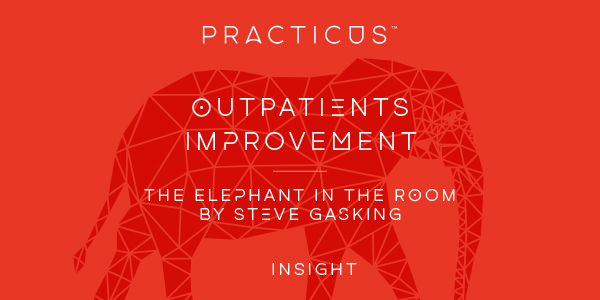Outpatients Improvement

As pressure on Outpatients performance increases, we speak to Steve Gasking, an interim transformation director with more than a decade’s experience in acute environments.
With a CV eleven pages long, it’s fair to say that Steve’s work improving and transforming hospital care is extensive. But there’s one solution to the challenges in Outpatients that’s been nagging at the back of his mind, one that few Trusts he encounters tackle.
It’s not the only solution but it is an ever-present elephant in the room – and one that could be vital given the increasing pressure on outpatients.
“Targets are an aggregate,” says Steve. “If you’re exceeding significantly against one of the components, it is possible to sacrifice a little bit of performance there to better resource weaker areas. That’s the theory. The problem is that in order to do that, you need to move your resources around a little and that means better job planning.”
Say job planning in many hospitals though and you wouldn’t be surprised to see a few eyes roll. It’s a divisive issue in the way that freeing up beds, improving patient care pathways and other measures simply aren’t.
“The issue,” as Steve sees it, “is that most job planning is thought about with a top down mentality by management. It becomes simplistic due to a lack of detailed understanding: we need this many procedures and we have this many consultants to do them. Take sub-specialities in areas like orthopaedics as an example. You may have 10 consultants who can do theatre work, but one of them sub-specialises in hands and can’t do feet, another in feet but not hands and so on. In short, unless you’ve got a really thorough and nuanced and ground-up understanding of who you’ve got and what they can be used for, you’re on a hiding to nothing. You need to understand your demand profiles and available capacity at subspecialty level.”
This is why job planning is usually the prerogative of a senior clinician, such as a clinical medical director. But this comes with its own issues too. Senior clinicians are not always masters of knotty management issues and the kind of extreme mental sudoku of planning a year out for everybody against predicted demand. They’re not selected for it, they’re often not trained for it and because of their proximity to the clinicians themselves, can be overly susceptible to upset colleagues or open to a degree of horse-trading for good will on other issues. There’s also the risk that if there is too much change to when and where someone works, it might be tantamount to changing their job, creating a potentially hazardous legal situation.
“It’s very easy for both management and clinicians to lose sight – unintentionally – of the end goal, patient care,” says Steve. “For many Trusts, it can become a tick box exercise, which isn’t to say it’s not hard work. It’s just that with a shortage of time and no shortage of pressure, job planning plays second fiddle and is not being used as effectively as it could be to drive value.”
Looking at job planning in isolation from the wider factors, Steve believes the task itself is not impossible, “It just needs time, a degree of objectivity and a team-based approach from management and clinicians. The best way to change it is to put the patient at the heart of it. That much should be abundantly clear. However, the benefits also need to be sold to clinicians and management alike. Yes, this takes time, it’s not easy and can be painful. But proper job planning will provide more time back than it takes up. It will cause less fire-fighting and crisis management later and ultimately, the patient wins.”
If you have any questions or comments for Steve, please contact Lisa at Practicus on 0117 9221777.
